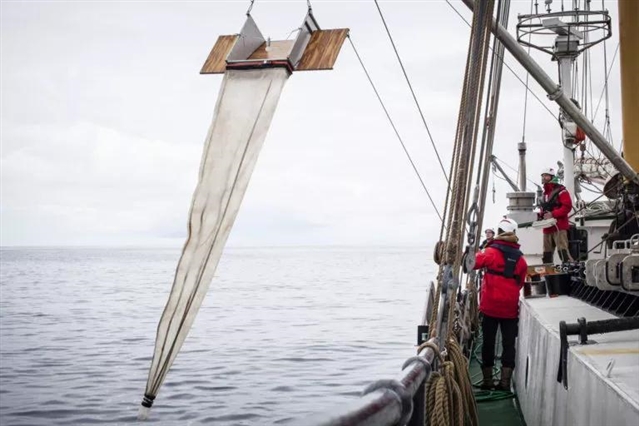|
|
| 危险的微粒:当你的外卖餐盒流进鲸鱼的身体 | Springer Open |
|
论文标题:Marine litter plastics and microplastics and their toxic chemicals components: the need for urgent preventive measures
期刊:Environmental Sciences Europe
作者:Frederic Gallo, Cristina Fossi, Roland Weber, David Santillo, Joao Sousa, Imogen Ingram, Angel Nadal and Dolores Romano
发表时间:2018/04/18
数字识别码:10.1186/s12302-018-0139-z
原文链接:https://enveurope.springeropen.com/articles/10.1186/s12302-018-0139-z?utm_source=WeChat&utm_medium=Website_linksSocial_media_organic&utm_content=CelZha-MixedBrand-multijournal-Multidisciplinary-China&utm_campaign=ORG_AWA_CZH_BMCWechat_dailyposts_blogs
微信链接:https://mp.weixin.qq.com/s/0i8szTWYCs7MaITz4THNkw
原文作者:Frederic Gallo, Cristina Fossi, Roland Weber, David Santillo, Joao Sousa, Imogen Ingram, Angel Nadal and Dolores Romano
海洋塑料污染是当今最重要的环境问题之一。最近Environmental Sciences Europe发表了一篇关于海洋塑料污染的最新研究成。该研究的主要负责人Frederic Gallo向我们介绍了这些塑料微粒对海洋生物造成的灾难性后果,他们制定的针对性预防措施,以及全球各地的同仁们正为此所做的努力抗争。

图1. © Richard Carey / stock.adobe.com
塑料,是一种非常有用的材料,具有诸多优点,包括轻便,具有化学惰性,亦柔亦刚,可以呈现为透明、半透明或不透明,可塑性强,可以被制造成任何形状等。塑料被广泛地用于食品和饮料包装领域,常见于各种日常用品和器具等。
塑料的大规模工业生产始于20世纪50年代,从那时起,它们不断地渗透我们的生活:在西欧和北美,每年的人均塑料消费量达100公斤,亚洲为20公斤。不难想象,随着城市人口的增加,这些数字将在亚洲或非洲人口稠密的发展中国家迅速增长。
然而,恰恰是人们对它的青睐和不断增长的使用量加重了它对自然环境的威胁,特别是将海洋环境逼入窘境。每年,全球有超过800万吨塑料垃圾没有经过妥善处理,流入了大海。
塑料袋、瓶子、包装等塑料垃圾一旦进入海洋,就会经历数十年的光降解和其他风化过程,最终会分解成数毫米大小甚至纳米尺度的的塑料微粒,最后会被小至浮游生物大至须鲸的各类海洋生物吞食。
就像任何新的研究领域一样,目前对于海洋塑料污染的后果,疑问多于确定。目前认为塑料微粒是海洋污染的一个普遍而复杂的原因,它会携带高浓度的化学添加剂,如内分泌干扰物(EDCs),同时也能吸附和浓缩水中的污染物质。因此,这些塑料微粒会增加海洋物种与危险化学品的接触机会,产生无法预料的后果。
了解后果&寻求解决方案
如果“任其发展”的话,预计到2050年,海洋中的塑料就会比鱼类更多。我们最近发表的论文,关注了塑料制品中常见的化学添加剂对海洋产生的化学污染,介绍了塑料垃圾在所有海洋中不断累积的后果。我们发现这些化学物质中的内分泌干扰物会影响海洋生物的多样性,甚至威胁人类的健康。
应对海洋塑料的解决方案应当考虑产品和基础设施设计以及消费者行为。在论文中,我们提出了以下措施:
• 鼓励减少塑料废物,支持在海洋环境中开发和使用更安全或更无害的替代品来代替持久存在的塑料。
• 提倡替代和绿色化学,避免在塑料中使用有害化学物质,特别是内分泌干扰物(EDCs)。
• 鼓励生态设计,使产品设计具有更好的包装可回收性。
• 在条件允许的情况下鼓励塑料垃圾回收。
• 鼓励人们改变消费行为,进行垃圾分类。
• 帮助发展中国家、转型中的经济体和小岛屿发展中国家对塑料垃圾和塑料包装进行有效收集和无害化处理。因为这些国家在一些情况下无法将塑料垃圾以环保的方式进行处理或回收,却还不得不继续接收这些垃圾。帮助包括在生产者延伸责任(Extended Producer Responsibility,EPR)的计划下实施回收或退回政策。
本论文的作者包括环境化学家,海洋学家以及环境保护主义者。其中,来自英国埃克塞特大学绿色和平科学实验室的David Santillo博士最近对苏格兰海域的塑料微粒进行了一项研究(如图所示)。“已经可以肯定,海水中塑料微粒的存在会对海洋生物的生理与行为产生影响“,David表示,“即使在地处偏远水域的苏格兰西北海岸的赫布里底群岛(Hebrides)附近,塑料微粒已经成为破坏海洋生态系统结构的一部分,这种威胁不容忽视,亟需紧急调查。”

图2. 2017年5月,在苏格兰海域使用牵引的蝠网对塑料微粒进行取样。
照片由Will Rose / Greenpeace提供
在瑞士IUCN(国际自然保护联盟)工作的生物技术工程师Joao Sousa刚刚在瑞典和芬兰完成了一次科考,并在那里收集了海洋中的冰芯。结果证实,北极冰中已含有一定浓度的塑料微粒,其浓度远远超过此前报道过的高污染海域,这种现象就是所谓的“塑料环流”。
这一发现引起了对人类健康问题严重的担忧,因为大约40%(以重量计算)的美国商业水产来自白令海,并且欧盟消费的鱼类中约有50%来自北冰洋海域。
来自锡耶纳大学(意大利)的Cristina Fossi教授研究了20年来污染物对地中海海洋生物的影响以及近年来对加利福尼亚湾的影响。她在2012年发表了第一篇关于塑料微粒对须鲸影响的论文,研究表明这种物种受塑料微粒的影响很巨大,因为每次鲸鱼张嘴时,它都会过滤掉70,000升的水!
由于塑料本身充满了污染物特别是邻苯二甲酸盐,双酚A(Biphenyl A),多溴联苯醚(PBDEs)等塑料添加剂,因此所有这些小块塑料都会对生物体产生毒性。当它们被鱼吃进胃里时,这些污染物便被释放出来并产生毒性作用,影响该鱼的内分泌系统及其性激素水平。
Fossi教授及其同事正试图利用生物分子学技术来确定塑料微粒携带的污染物在整个食物链中的影响。例如,通过使用定量PCR、免疫印迹(WB)和基因表达等技术来测量蛋白质或DNA损伤的上升或下降情况。她目前正在领导一个名为塑料克星(Plastic Busters)的欧盟项目,旨在评估海洋垃圾的数量,来源,途径,会聚区,以及对生物种群的影响,以及缓解并减轻海洋垃圾对地中海的影响。
摘要:
Persistent plastics, with an estimated lifetime for degradation of hundreds of years in marine conditions, can break up into micro- and nanoplastics over shorter timescales, thus facilitating their uptake by marine biota throughout the food chain. These polymers may contain chemical additives and contaminants, including some known endocrine disruptors that may be harmful at extremely low concentrations for marine biota, thus posing potential risks to marine ecosystems, biodiversity and food availability. Although there is still need to carry out focused scientific research to fill the knowledge gaps about the impacts of plastic litter in the marine environment (Wagner et al. in Environ Sci Eur 26:9,2014), the food chain and human health, existing scientific evidence and concerns are already sufficient to support actions by the scientific, industry, policy and civil society communities to curb the ongoing flow of plastics and the toxic chemicals they contain into the marine environment. Without immediate strong preventive measures, the environmental impacts and the economic costs are set only to become worse, even in the short term. Continued increases in plastic production and consumption, combined with wasteful uses, inefficient waste collection infrastructures and insufficient waste management facilities, especially in developing countries, mean that even achieving already established objectives for reductions in marine litter remains a huge challenge, and one unlikely to be met without a fundamental rethink of the ways in which we consume plastics. This document was prepared by a working group of Regional Centres of the Stockholm and Basel Conventions and related colleagues intended to be a background document for discussion in the 2017 Conference of the Parties (COP) of the Basel Convention on hazardous wastes and the Stockholm Convention on persistent organic pollutants (POPs). The COP finally approved that the issue of plastic waste could be dealt by its Regional Centres and consistently report their activities on the matter to next COP’s meetings.
阅读论文全文请访问:
https://enveurope.springeropen.com/articles/10.1186/s12302-018-0139-z?utm_source=WeChat&utm_medium=Website_linksSocial_media_organic&utm_content=CelZha-MixedBrand-multijournal-Multidisciplinary-China&utm_campaign=ORG_AWA_CZH_BMCWechat_dailyposts_blogs
期刊介绍:
ESEU(https://enveurope.springeropen.com/,4.040 -2-year Impact factor) is an international journal, focusing primarily on Europe, with a broad scope covering all aspects of environmental sciences, including the main topic regulation.
(来源:科学网)
特别声明:本文转载仅仅是出于传播信息的需要,并不意味着代表本网站观点或证实其内容的真实性;如其他媒体、网站或个人从本网站转载使用,须保留本网站注明的“来源”,并自负版权等法律责任;作者如果不希望被转载或者联系转载稿费等事宜,请与我们接洽。